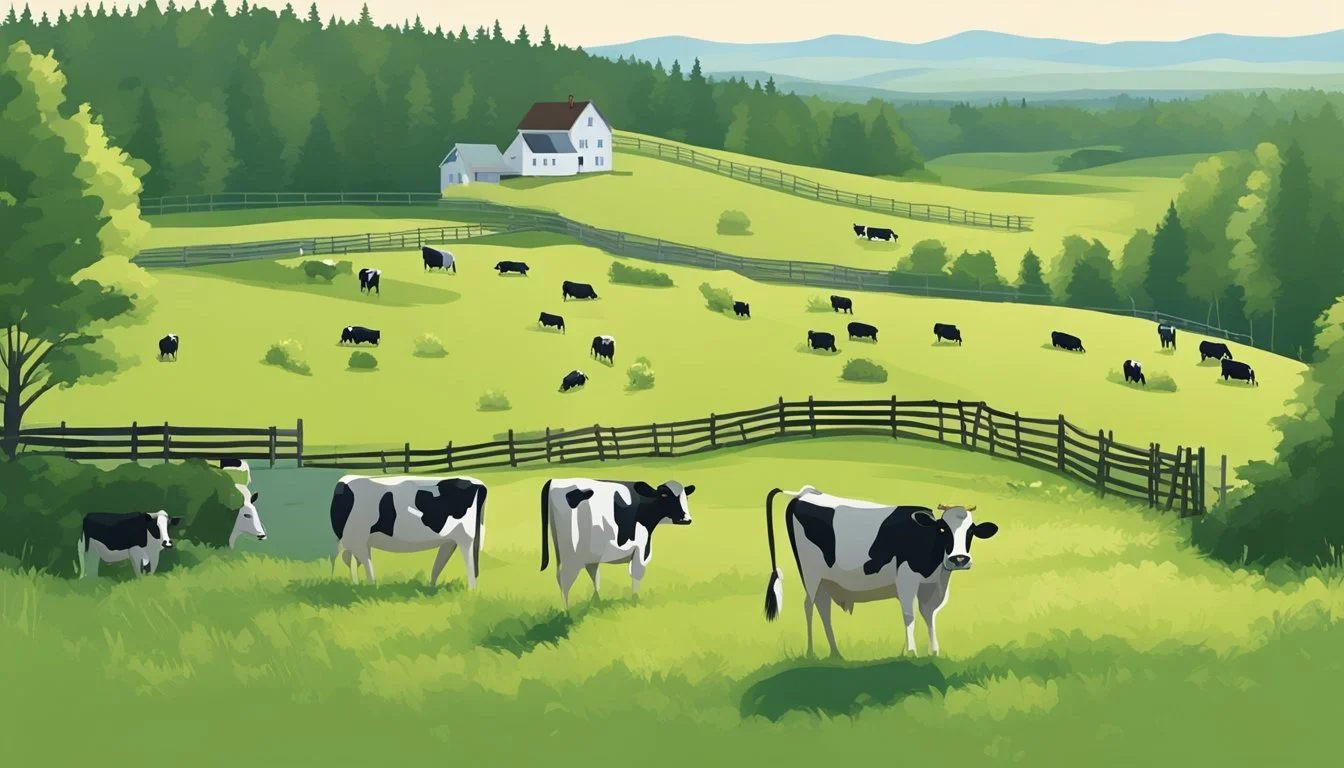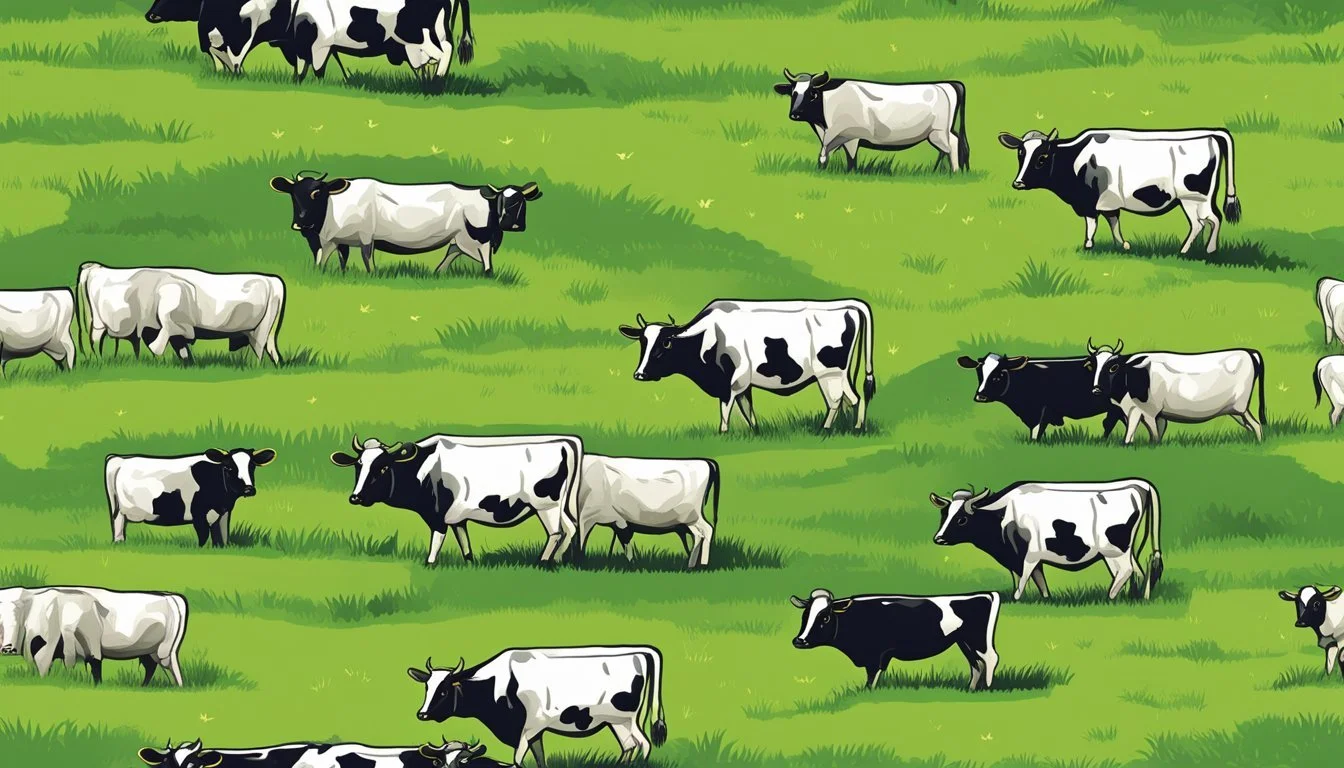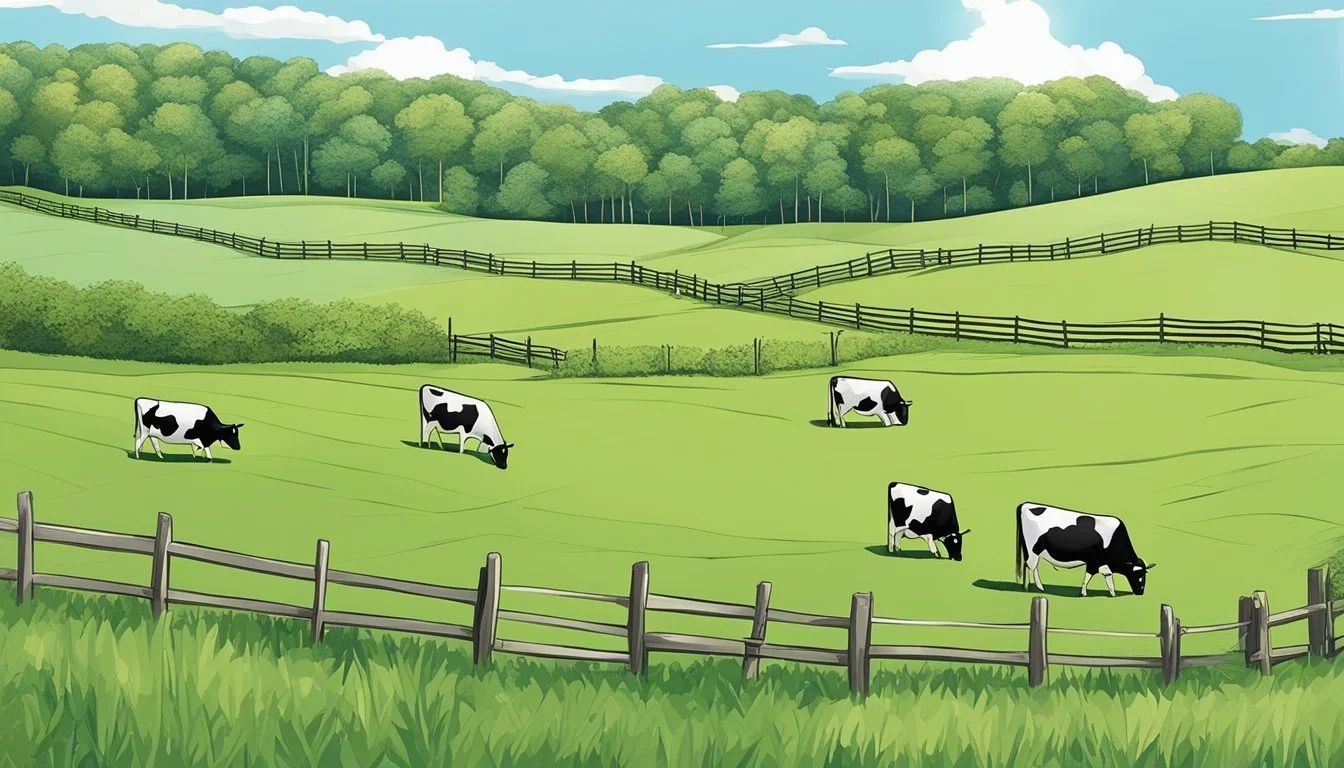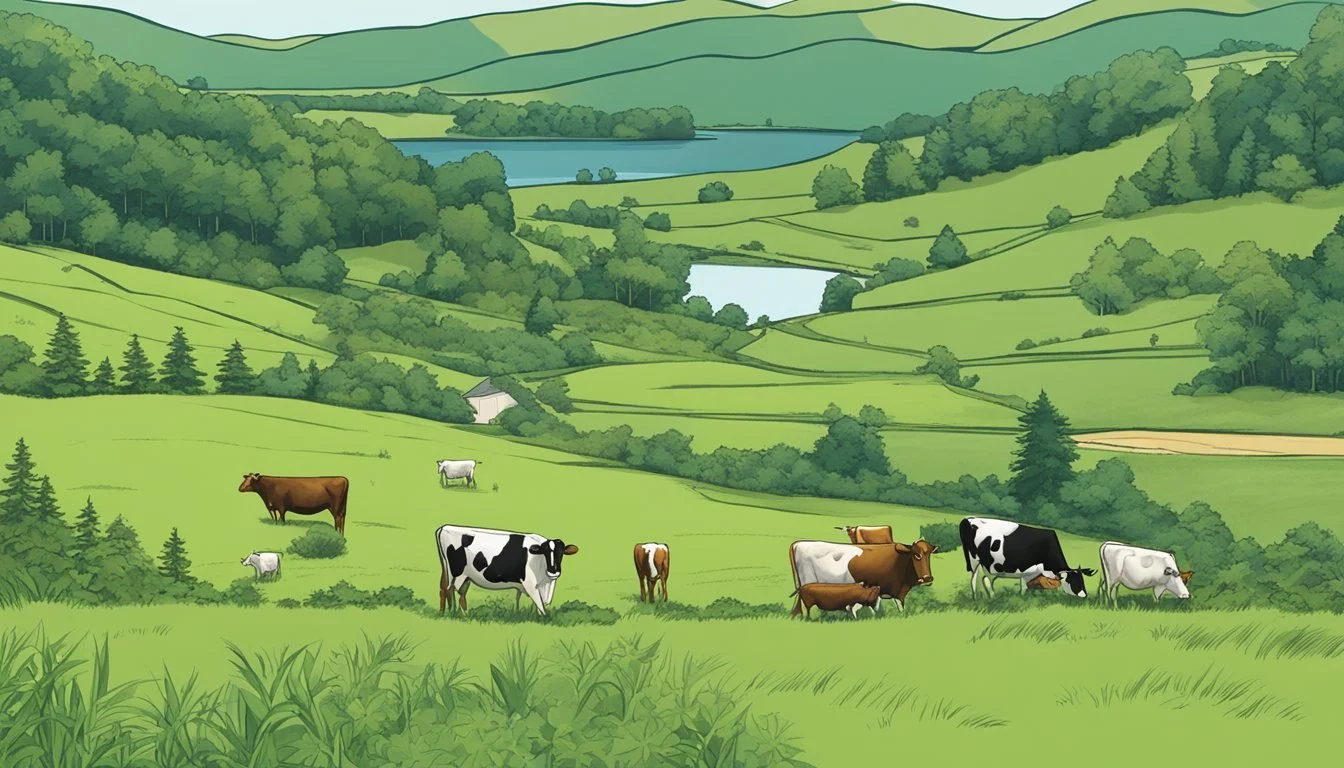Stocking Rate Maine
Determining the Ideal Cows Per Acre for Your Land
Determining the appropriate stocking rate is critical for sustainable livestock production in Maine. Stocking rate refers to the number of cows or other livestock that can be supported per acre without causing damage to the environment or the viability of the pasture. It is a balance between the forage demand of the livestock and the forage availability from the land. In Maine, the varying climate conditions and the quality of pastureland play significant roles in influencing the carrying capacity of farm properties.
In Maine's diverse agricultural landscape, proper grazing management ensures the health of the pasture, the animals, and the overall ecosystem. Livestock producers must consider local resources and adjust stocking rates to seasonal changes in forage production. This adjustment is necessary to avoid overgrazing, which can lead to soil degradation and reduced forage quality. Sustainable stocking rates are thus economically beneficial to farmers and ecologically responsible.
To establish an effective grazing plan, Maine farmers must evaluate several factors including soil type, pasture health, forage species, and climatic conditions. This comprehensive approach to grazing management helps to maintain the productivity and sustainability of Maine’s pastures, ensuring that the land can support livestock not only in the current season but also for years to come. Through careful planning and continuous monitoring, farmers can determine the optimal stocking rate to meet their goals for livestock production.
Understanding Stocking Rate
Stocking rate is the fundamental measure that aligns the number of livestock with the available pasture resources, ensuring a balance that maintains animal health and land sustainability.
Key Concepts and Definitions
Stocking rate is typically measured in animal unit months (AUM) or animal unit days (AUD), which are standard units representing the forage demand of a 1000-pound cow for one month or one day, respectively. Carrying capacity is the maximum number of animals that the land can support year-round without deteriorating. This term is deeply intertwined with the concept of stocking rate, as it serves as a benchmark for determining the appropriate stocking rate. A single cow per acre is a simplified measure often cited, but the actual rate depends on various factors specific to the land in question.
Stocking Rate Calculation Basics
The basic equation to compute stocking rate is: Total Land Area ÷ [(Number of Animal Units) x (Grazing Season)]
For example, if a farm has 200 acres and 50 head of 1,000-pound cows (presumed to be 50 animal units) grazing for 12 months, it would be calculated as:
200 acres ÷ (50 animal units × 12 months) = 0.33 acres per animal unit month (AUM)
These calculations offer a starting point but must consider the unique characteristics of the pasture, such as forage production and nutritional values.
Importance of Accurate Stocking
Precise determination of stocking rates is crucial. Overstocking leads to land degradation and poor animal health, while understocking results in wasted resources. Accurate stocking supports long-term productivity through sustainable forage use. Adjustments may be necessary due to fluctuating conditions like weather patterns or natural events. Flexibility in managing stocking rates is key to compensate for these potential changes.
Land Assessment and Pasture Management
To properly support livestock, a tailored approach to assessing land capacity and managing pastures is crucial. This involves analyzing the specific conditions of the land and the quality of available forage.
Evaluating Pasture Conditions
A critical first step is to evaluate the terrain of the property. Maine's variable climate can impact pasture conditions, necessitating a thorough inspection of the land to ensure it can support grazing. Factors such as soil health, topography, and water availability influence the carrying capacity. Regular monitoring helps identify signs of overgrazing, which may include soil compaction, reduced grass regrowth rates, and the appearance of undesirable plant species. Integrating proper management practices can prevent degradation. Pasture size also plays a pivotal role; larger areas provide more room for rotational grazing, a method that allows sections of pasture to rest and regrow.
Forage Quality and Production
It's essential to understand the forage quality and production levels that the land can sustain to maintain a healthy herd. Maine's grazing season varies depending on its climate; forage production is closely tied to this timeframe. A pasture must provide adequate nutrition, requiring a balance of grasses and legumes tailored to the livestock's needs. Management practices should aim to enhance forage yield and maintain a consistent production throughout the viable grazing months. This not only supports the livestock’s dietary needs but also contributes to the soil health. Field tests for nutrient content and the application of fertilizers, where necessary, improve forage quality and maintain the land's size and productivity for future use.
Optimizing Forage Utilization
Proper grazing management techniques ensure optimal forage utilization. This allows for maintaining animal performance and forage sustainability throughout the grazing season.
Grazing Methods
Rotational grazing involves dividing pasture land into smaller areas, called paddocks, and moving livestock between them. This method allows forage plants to recover between grazing periods, potentially increasing the utilization rate and productivity of the pasture. Continuous grazing, on the other hand, allows livestock to graze freely across all areas, which can lead to uneven forage utilization and may reduce overall pasture productivity.
Rotational Grazing Benefits:
Enhances forage regrowth
Improves pasture utilization
Continuous Grazing Concerns:
May lead to overgrazing in preferred areas
Can reduce forage availability over time
Grazing Periods and Rest
The two key components in grazing management are the grazing period and rest period. The grazing period is the time when livestock actively grazes a specific paddock, while the rest period follows, allowing the forage to recover.
Recommended Practices:
Short, intense grazing periods with adequate rest to maximize forage recovery.
Monitoring to adjust grazing and rest periods based on forage growth rates.
Maintaining an appropriate balance between forage demand and forage utilization is crucial for sustaining pasture health. Producers should aim to adjust grazing methods and periods to meet the forage's growth dynamic, ensuring a stable and efficient food resource for livestock throughout the grazing season.
Calculating Cows Per Acre for Maine
Determining the appropriate stocking rate in Maine involves an understanding of local agricultural conditions and forage availability. This section will guide property owners in Maine through the process of calculating how many cows per acre their land can support.
Local Factors Affecting Stocking Rate
Numerous local factors in Maine must be considered to accurately calculate the appropriate number of cows per acre. These include:
Climate: Maine's climate is characterized by cold winters and mild to warm summers. This impacts forage growth cycles and the availability of grasses and other feed sources throughout the year.
Precipitation: The amount and distribution of rainfall affect grass growth. It's essential to monitor local weather patterns and account for variations in precipitation.
Forage Type: The quality of forage, such as different species of grasses, clover, and rye, has a significant impact on the carrying capacity. Forage testing can help determine nutritional content and digestibility.
Soil Fertility: Soil condition and fertility influence forage production and must be assessed to optimize pasture yield.
Typical Maine Stocking Rates
Stocking rates in Maine can vary, but there are general guidelines based on local forage production:
Pasture-Based Systems: Estimates for pasture-rotation systems in Maine suggest an average stocking rate at which an acre can support a certain number of cows. On average, it's reasonable to start with the assumption of 2 to 3 cows per 5 acres, considering a balance between forage availability and the needs of the cows.
Forage Production: Calculations based on the University of Maine Cooperative Extension suggest that with 2250 lbs of forage per acre at a 0.5 utilization rate, one can support approximately 10,714 lbs of liveweight per acre.
To illustrate, using a general formula:
[ \text{Cows per Acre} = \frac{\text{Total Forage per Acre} (\text{lbs}) \times \text{Utilization Rate}}{\text{Average Liveweight per Cow} (\text{lbs})} ]
For instance, if an acre produces 2250 lbs of forage and the desired utilization rate is 50% with an average cow weight of 1200 lbs:
[ \text{Cows per Acre} = \frac{2250 \times 0.5}{1200} \approx 0.94 ]
The above calculation yields just under one cow per acre under those conditions.
Adjusting for variations in climate, forage types, and other local conditions is necessary for more precise calculations. It is recommended for property owners to consult with local agricultural extensions to refine these numbers for their specific location in Maine.
Animal Nutrition and Performance
Determining the appropriate number of cows per acre in Maine involves understanding the nutritional needs of the livestock and how these needs affect animal performance. Ensuring animals receive sufficient energy to achieve daily gain targets is essential for operational success.
Assessing Animal Requirements
Livestock require a balanced diet to maintain health and productivity. The animal's age, weight, and production stage are critical factors influencing their nutritional needs. For example, a lactating cow has higher energy requirements compared to a non-lactating one. Their diet must contain adequate carbohydrates, proteins, vitamins, and minerals to sustain daily activities and growth.
Key nutritional needs for livestock include:
Energy: The most critical component, typically sourced from forages and grains.
Protein: Essential for growth and reproductive functions.
Proteins are derived both from pasture and supplemental feeds.
Vitamins and Minerals: Vital for immune function and bone development.
Linking Nutrition to Stock Density
The stock density on a property can significantly impact the availability and quality of forage, thus affecting animal nutrition. If the stocking rate exceeds the land's carrying capacity, the nutritional value of the pastures could diminish, leading to suboptimal animal performance. On the other hand, understocking can lead to wastage of forage and potential overgrowth that decreases its nutritive value.
To link nutrition and stock density, consider:
Forage Quality: Higher quality forages can support higher stock densities.
Supplementation: If natural forage cannot meet the animals' dietary needs, supplements become necessary.
Grain Feeding: Implementing a grain-feeding program may allow for higher stock densities.
Effective management ensures that livestock receive adequate nutrition to support their health and growth, which is directly related to the capacity of the land to sustain a certain number of animals.
Environmental Impacts and Sustainability
Maintaining the balance between a productive livestock operation and the health of the environment is critical. Sustainable stocking rates in Maine not only support the financial viability of a farm but also help protect the ecosystem.
Managing Grazing to Prevent Degradation
Proper grazing management is essential to prevent soil degradation and desertification, crucial concerns in maintaining pasture health in Maine. Farmers can prevent overgrazing by implementing rotational grazing, which allows pastures time to recover and supports biodiversity. Monitoring the grazing days per acre and adjusting the livestock numbers accordingly helps to maintain the balance between livestock needs and the land's capacity.
Rotational Grazing: Rotational grazing involves moving livestock between pastures to allow vegetation recovery time, promoting a richer biodiversity and preventing overgrazing.
Stocking Rates: Adhering to recommended stocking rates to avoid overburdening the pasture, leading to soil exposure and erosion.
Sustainable Grazing Systems
A sustainable grazing system ensures that the carrying capacity of the land supports the livestock without compromising the ecosystem. It involves:
Soil Conservation: Practices such as no-till farming can reduce soil degradation.
Forage Diversity: Planting a diversity of forage species can increase pasture resilience and reduce the risk of desertification.
Land Management: Proper land management includes soil testing, reseeding, and fertilization in accordance with environmental guidelines to enhance pasture productivity and extend grazing days.
Water Resources: Efficient use and protection of water resources are critical, as livestock operations depend on clean water for both the animals and forage growth.
Projected Trends in Forage and Stocking
In Maine, the ability to support livestock, specifically cows, is directly influenced by forage production and stocking densities. Future projections must consider the effects of climate on forage availability and the necessary adaptations to maintain or improve stocking rates.
Future Forage Availability
Forage production in Maine is expected to undergo changes due to climate influences. Warmer temperatures may extend the grazing season but could also affect the types of forage plants that can thrive. Producers need to monitor trends in forage dry matter yields to anticipate whether the future will bring increases or decreases in available feedstock.
Projected forage trends:
Increased temperature: May lead to a longer growing season.
Precipitation changes: Can influence forage quality and quantity.
Forage species shifts: Non-native species may become more prevalent.
Adapting to Changing Conditions
Successful livestock managers will need to adapt their practices to the changing forage landscapes. This includes adjusting stocking rates to match the predicted forage climate impacts, maintaining a balance between animal numbers and available forage to avoid overgrazing.
Adaptive strategies may include:
Rotational grazing: Utilizing different pastures to allow forage recovery.
Supplementary feeding: Providing additional nutrients when forage is insufficient.
Drought-resistant forages: Planting species that can withstand drier conditions.
By proactively managing forage resources and stocking densities, livestock operations in Maine can achieve resilience in the face of climate variability and ensure the sustainability of their enterprises.
Advanced Grazing Techniques
To optimize stocking rates in Maine, advanced grazing techniques need to be implemented with precision. These practices enable better utilization of pastures and can support a higher number of cows per acre without degrading the land.
Incorporating Multi-Species Grazing
Multi-species grazing involves livestock species with different grazing behaviors and dietary needs sharing the same pasture. For instance, goats or sheep may browse on shrubs and forbs, while cattle primarily graze on grasses. This technique supports improved pasture conditions by reducing the overgrazing of a single forage type and can disrupt the life cycles of species-specific parasites, reducing parasitic loads. Employing multi-species grazing leads to a more efficient feed resource utilization and can increase the overall carrying capacity of the pasture.
Utilizing a Pasture Inventory
Maintaining a pasture inventory is a crucial component of an advanced grazing method. This inventory should detail the quantity, quality, and growth rate of forage available in each pasture. It serves as the foundation for implementing rotational grazing, where livestock move between pastures to allow for forage regrowth and rest periods for the grazed areas. This strategy helps enhance forage production and ensures sustainable pasture use throughout the grazing season. An effective pasture inventory aligns grazing demands with forage supply, preventing overstocking and promoting optimal animal performance.
Case Studies and Practical Examples
In Maine, farmers approach stocking rates with careful consideration, applying data-driven practices to ensure sustainable grazing while maximizing their land’s potential.
Small-Scale Farm Strategies
A small-scale farm in Maine with 8 acres of pasture adopted a rotational grazing system for their steers. They start the grazing period on May 1 with careful monitoring. By rotating the cattle frequently to avoid overgrazing, the farm supports a higher stocking rate than traditional continuous grazing systems. For example:
May 1 - August: 2 steers per acre with rotations every 7 days.
Maintains pasture health and meets forage intake needs.
Mid to Large Pasture Implementations
Conversely, a larger farm with 100 acres follows a mixed strategy to support a cow/calf pair operation. They divide the land into parcels to allow for both continuous and rotational grazing, using natural forage and supplemental feeding when necessary. Their stocking rate adjusts for variables such as forage availability and animal weight, typically:
1 cow/calf pair per 2-3 acres on rotational parcels.
1 cow/calf pair per 4-5 acres on continuous grazing areas.
In both cases, farmers in Maine employ strategic planning based on land size and cattle needs, ensuring animal health and pasture sustainability are equally prioritized.







